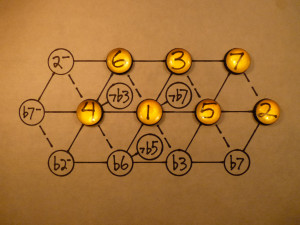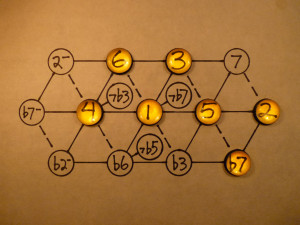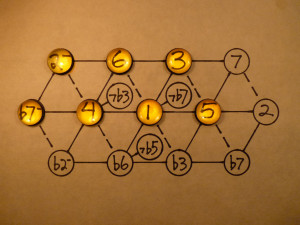Mixolydian Mode
I’ve been quiet lately because I’ve been working on an animation of my song Real Girl. It’s a complicated one, a dance of harmonic tension and resolution. The bass and melody chase each other around the lattice like courting butterflies.
Meanwhile, there’s more to be extracted from the Be Love video.
A mode is a type of scale, characterized by the pattern of intervals between its notes. The note spacings stay the same no matter what key it’s in. When we say a song is in A major, we mean the tonic is A, and the mode is major. The major mode, also called Ionian, is the familiar Do-re-mi-fa-sol-la-ti-do.
Any combination of notes, covering an octave and organized in pitch order, can be a mode. There is a particular set of modes, often called church modes, that can be played on the white keys of the piano. The different modes start on different notes. The major mode goes from C to C; Aeolian, or minor mode, runs from A to A. Stick to the white keys, and the notes will be right for that mode.
Ionian and Aeolian are the commonest modes in modern Western music, but Dorian (D to D) and Mixolydian (G to G) are popular too.
I wrote the chorus of Be Love first. It’s in major mode. I wanted the verse to have a different feel, so I decided to make it Mixolydian — a favorite for several reasons. I love the name. And, as Mathieu points out in his book Harmonic Experience, it’s particularly easy to improvise over. It’s common in rock music from the seventies on — see the BTO clip in this post. My song Driving is mostly in Mixolydian mode.
The big reason I wanted the change was to make the chorus more of an anthem, by contrast. Mixolydian has a dark, beefy quality to me, and when the chorus comes around it sounds like the sun is coming out.
In equal temperament, there is only one difference between major and Mixolydian scales. The seventh degree is minor instead of major. Starting with G, and going up the white keys, you get G-A-B-C-D-E-F-G. The G major scale goes G-A-B-C-D-E-F#-G. Only the seventh is different.
In just intonation, the situation is a bit different. There are three b7s in the inner lattice: b7, b7-, and 7b7. Which to choose?
Here is the major scale.
One possibility is to just drop the 7 to the b7:
I like the interpretation below. It uses the b7-, and also changes the 2 to a 2-.
This gives me an in-tune major flatted seventh chord, which I love. In the key of G that’s F major — lots of rock music uses this chord.
The notes of this scale (Western Mixolydian?) are in the same relationship to each other as the notes of the major scale, shifted one space to the left. The intervals are just as consonant as the major scale ones, only arranged in a different order.
It’s easy to write chord progressions in this mode. Major and minor triads form triangles on the lattice (major triads point up, and minor ones point down) and there are five in-tune triads, just like the major scale. Since the triangles are all connected, moving from one to another feels natural and is easy for the ear to follow.
Again I refer to Mathieu’s book. Have I lately? In Harmonic Experience he writes about “matchstick harmony.” Cool stuff.
Here is the scale, animated against a drone.
Next: Mixolydian Matchsticks


